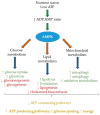Nutritional Modulation of AMPK-Impact upon Metabolic-Inflammation
- PMID: 30304866
- PMCID: PMC6213547
- DOI: 10.3390/ijms19103092
Nutritional Modulation of AMPK-Impact upon Metabolic-Inflammation
Abstract
Nutritional status provides metabolic substrates to activate AMP-Activated Protein Kinase (AMPK), the energy sensor that regulates metabolism. Recent evidence has demonstrated that AMPK has wider functions with respect to regulating immune cell metabolism and function. One such example is the regulatory role that AMPK has on NLRP3-inlflammasome and IL-1β biology. This in turn can result in subsequent negative downstream effects on glucose, lipid and insulin metabolism. Nutrient stress in the form of obesity can impact AMPK and whole-body metabolism, leading to complications such as type 2 diabetes and cancer risk. There is a lack of data regarding the nature and extent that nutrient status has on AMPK and metabolic-inflammation. However, emerging work elucidates to a direct role of individual nutrients on AMPK and metabolic-inflammation, as a possible means of modulating AMPK activity. The posit being to use such nutritional agents to re-configure metabolic-inflammation towards more oxidative phosphorylation and promote the resolution of inflammation. The complex paradigm will be discussed within the context of if/how dietary components, nutrients including fatty acids and non-nutrient food components, such as resveratrol, berberine, curcumin and the flavonoid genistein, modulate AMPK dependent processes relating to inflammation and metabolism.
Keywords: AMPK; IL-1β; NLRP3; dietary fatty acids; metabolic-inflammation; nutrigenomics; nutrition.
Conflict of interest statement
The authors declare no conflict of interest.
Figures


Similar articles
-
Dietary modulation of energy homoeostasis and metabolic-inflammation.Proc Nutr Soc. 2019 Aug;78(3):313-318. doi: 10.1017/S0029665118002872. Epub 2019 Feb 1. Proc Nutr Soc. 2019. PMID: 30704542 Review.
-
AMPK Regulation of Glucose, Lipid and Protein Metabolism: Mechanisms and Nutritional Significance.Curr Protein Pept Sci. 2017;18(6):562-570. doi: 10.2174/1389203717666160627071125. Curr Protein Pept Sci. 2017. PMID: 27356941 Review.
-
Sensing of energy and nutrients by AMP-activated protein kinase.Am J Clin Nutr. 2011 Apr;93(4):891S-6. doi: 10.3945/ajcn.110.001925. Epub 2011 Feb 16. Am J Clin Nutr. 2011. PMID: 21325438 Review.
-
[AMP-activated protein kinase (AMPK) as therapeutic target].Postepy Hig Med Dosw (Online). 2013 Aug 5;67:750-60. doi: 10.5604/17322693.1061403. Postepy Hig Med Dosw (Online). 2013. PMID: 24018441 Review. Polish.
-
Glucose availability but not changes in pancreatic hormones sensitizes hepatic AMPK activity during nutritional transition in rodents.J Biol Chem. 2020 May 1;295(18):5836-5849. doi: 10.1074/jbc.RA119.010244. Epub 2020 Mar 17. J Biol Chem. 2020. PMID: 32184359 Free PMC article.
Cited by
-
Neuroendocrine Tumors: A Comprehensive Review on Nutritional Approaches.Cancers (Basel). 2022 Sep 10;14(18):4402. doi: 10.3390/cancers14184402. Cancers (Basel). 2022. PMID: 36139562 Free PMC article. Review.
-
The protective effect of selenoprotein M on non-alcoholic fatty liver disease: the role of the AMPKα1-MFN2 pathway and Parkin mitophagy.Cell Mol Life Sci. 2022 Jun 9;79(7):354. doi: 10.1007/s00018-022-04385-0. Cell Mol Life Sci. 2022. PMID: 35678878 Free PMC article.
-
Insight into Potential Interactions of Thyroid Hormones, Sex Hormones and Their Stimulating Hormones in the Development of Non-Alcoholic Fatty Liver Disease.Metabolites. 2022 Aug 4;12(8):718. doi: 10.3390/metabo12080718. Metabolites. 2022. PMID: 36005590 Free PMC article. Review.
-
Role of autophagy in atherosclerosis: foe or friend?J Inflamm (Lond). 2019 May 2;16:8. doi: 10.1186/s12950-019-0212-4. eCollection 2019. J Inflamm (Lond). 2019. PMID: 31073280 Free PMC article. Review.
-
Novel role of xanthine oxidase-dependent H2O2 production in 12/15-lipoxygenase-mediated de novo lipogenesis, triglyceride biosynthesis and weight gain.Redox Biol. 2021 Nov;47:102163. doi: 10.1016/j.redox.2021.102163. Epub 2021 Oct 12. Redox Biol. 2021. PMID: 34655995 Free PMC article.
References
-
- Finucane O.M., Lyons C.L., Murphy A.M., Reynolds C.M., Klinger R., Healy N.P., Cooke A.A., Coll R.C., McAllan L., Nilaweera K.N., et al. Monounsaturated fatty acid-enriched high-fat diets impede adipose NLRP3 inflammasome-mediated IL-1? Secretion and insulin resistance despite obesity. Diabetes. 2015;64:2116–2128. doi: 10.2337/db14-1098. - DOI - PubMed
-
- Hawley S.A., Davison M., Woods A., Davies S.P., Beri R.K., Carling D., Hardie D.G. Characterization of the AMP-activated protein kinase kinase from rat liver and identification of threonine 172 as the major site at which it phosphorylates AMP-activated protein kinase. J. Biol. Chem. 1996;271:27879–27887. doi: 10.1074/jbc.271.44.27879. - DOI - PubMed
Publication types
MeSH terms
Substances
LinkOut - more resources
Full Text Sources
Medical

